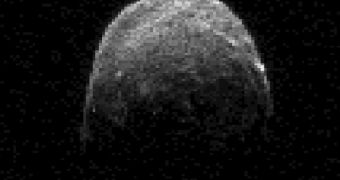The Goldstone, California-based NASA Deep Space Network (DSN) antenna has collected the first close-up images of asteroid 2005 YU55. The space rock caused quite a stir among those who are frightful that the world will end soon. Other observations of the asteroid will begin today.
The DSN is a 70-meter (230-foot) radio antenna, which is capable of conducting radio observations of small space bodies, such as asteroids. The recent target is about the size of an aircraft carrier, which makes studies all the more easier.
When observations began, on November 7, the space rock was about 860,000 miles (1.38 million kilometers) away from Earth. The actual study began at 11:45 am PST (1945 UTC), and lasted for about two hours.
Additional studies are scheduled to take place all the way to November 10, for about 4 hours each day. The point of closest approached will be reached today, November 8, at around 3:28 pm PST (6:28 pm EST, 1128 UTC), Space reports.
Instances when asteroids as large as 2005 YU55 pass so close to the planet are rather rare. The last such event occurred in 1976, whereas the next one is not scheduled until 2028. Yet, astronomers have no way of knowing for sure that large space rocks did not zip past Earth.
The technologies required to observe such events occurring have only been developed to their full potential in recent years. The past decade saw the launch of infrared observatories that revealed the existence of thousands of near-Earth objects around our planet.
Starting today, the massive Arecibo Planetary Radar Facility, in Puerto Rico, will also begin studying the asteroid. The 305-meter (1,000-foot) observatory is the largest single-dish radio telescope in the world, and achieves pointing through the rotation of the planet.
“The trajectory of asteroid 2005 YU55 is well understood. At the point of closest approach, it will be no closer than 201,700 miles (324,600 kilometers) as measured from the center of Earth, or about 0.85 times the distance from the moon to Earth,” a Jet Propulsion Laboratory press release reads.
“The gravitational influence of the asteroid will have no detectable effect on Earth, including tides and tectonic plates,” says the Pasadena, California-based science team. The JPL often conducts studies using the DSN atenna.
“Although the asteroid is in an orbit that regularly brings it to the vicinity of Earth, Venus and Mars, the 2011 encounter with Earth is the closest it has come for at least the last 200 years,” the scientists conclude.

 14 DAY TRIAL //
14 DAY TRIAL //